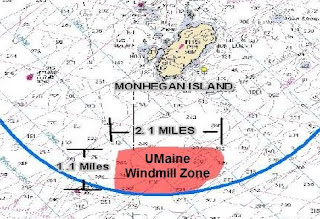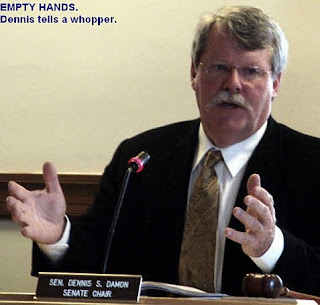T'was a fine time at the Alamo Theater in Bucksport last night. The Great Game playing out once more.
Both hours roared by; I couldn't believe it when it was noted but a few minutes remained...
See photos here.
Here are my recollections of the first hour: The entryway, where Sally Jones displayed used cores of rhyolite, which a first nations-er discarded on the island sometime during the last fifty centuries of the managing of Sears island 's natural resources by the Wabanaki and the red paint Maritime Archaic peoples. She issued Won't clam up! pins and en-coffined mourning-the-island visors to those entering the theater. And held forth to Tanya Mitchell, reporter from the Belfast newspaper.
Then off to the cavernous interior, where, on the long table on the raised stage where the five forumistas would sit sat, two water cups (speaking is thirsty work!) flanked each talker's table microphone.
A biot of sound checkery, and an introduction by Amy Brown. Then an explanation of the forum's process byWERU moderator Gray Parrot: Five minutes for each panelist to lay out their main points, then one question of another panelist by each panelist, then a question by the moderator for all the panelists to answer, then questions from the audience until the end.
Damon started off. He acknowledged multiple valid sides to the controversy, admitted that initially he and his committee had voted unanimously to condition the granting of the easement to a port wannabe first acquiring port permits. Baldacci convinced him to redo the vote, getting around Public Law 277 by having the Transportation Committee merely assent to a gubernatorial executive order accepting the conservation easement, and not assenting directly to MDOT's split the island plan;
[ Aside: this bit of legerdemain, by the way,angered some of the veteran committee members who were being asked to now vote unanimously AGAINST what they'd just voted unanimously FOR, amid heartily confused new legislators in the Transportation committee who complained they were being forced to vote in a rush, on the day this Sears Island thing landed in their laps, without rknowing hardly any details - and all because Damon had scheduled a bus trip to a fish hatchery for that afternoon! On little fish, this island's fate keeps pivoting.
In any case, Senator Damon said, the division of Sears Island for port and protected areas was the right thing.
Peter Taber was next He noted his 18 years of journalism in Waldo County; and his close following of, and reportage on, Sears Island development schemes by governor's Mckernan, King and Baldacci in his first term. He detailed at length the overall dishonesty and rigging of the process by each succeeding chief executive's government , the legislature and us congress, industry and NGO's alike.
Jim Freeman followed. He noted his 25 years in Maine, his 15 years of activism around defense of Sears island. He agreed Sears Island was "an incredible place", extolled its fish nursery, noted he'd been involved in protecting ii in the 90's and early '00's, but , fearing the state might sell the island to condominium development, decided that saving part of it by the state giving MCHT a conservation easement over the east side was better than nothing. And besides there might never be a port on the other side since Mack Point across the bay isn't filled to capacity. Thus he joined the MDOT's Sears Island Joint Use Planning Committee and went with their flow.
David Cole of Maine DOT described the state's plan for a "trans-shipment" container port, one that could send double stacked containers by rail from ships docking at Sears Island to depots in the midwestern US by way of Montreal. Rail is the "most environmentally friendly" of all transportation modes anyway, he noted. One-third the carbon footprint.
I was next. I noted that a "trans-shipment container port" meant that
it would not carry Maine-bound goods; those would all continue to come into and around the state by truck or other ports. The transhipment rail line would take the containers form the ship and directly through and out of Maine unopened. I also noted that a containerport is a heavy air polluter: the ships, trains, trucks and cranes all running their petrol-burning engines at once all the time. The upper bay would become an asthma cluster zone in epidemiological studies. I noted that the island was set up at the interface between river and bay and its location was perfect for growing baby groundfish and other fishes (although the illegally created causeway's lack of culverts has diminished that function and must be pierced).
Then came questions from panelist to panelist:
Damon asked Peter why he was accusative, "inflammatory". Why do you choose to discredit? Peter replied with a detailed description of the perfidy perpetuated by Cole's agency and by Sierra Club, from SIPI's beginnings to the present. Damon said that the sell-out NGOs reserve the ability to question why 2/3 of the island was conserved.He's not convinced they are all on board. (Cole looked right uncomfortable hearing this this, as he did when Freeman next to him announced his lukewarm support of a port on the island.
Peter asked Damon to explain why he had earlier said that he was not sure of the sincerity of the people that signed onto the agreement; did he still feel that way.
Jim Freeman noted that he and I had worked together for years on Sears Island. Why, he asked, was I (RH) "on the outside" casting "wild allegations", and not on the inside being a part of JUPC? I replied that at the startup of the JUPC process I was busy suing Dragon Cement in Thomaston to make them cap their dusty CKD mound; when I saw the Sierra Club and Earth First!er Jim Freeman were on the Sears Island Joint Use Committee, I thought the island was safe - these people have never compromised when it came to protecting the entire island from development.
What a shoc, I said, to find out it wasn't so! Freeman and Sierra Club had consensed with MDOT against piercing the causeway! Had agreed a port was an "appropriate use" of western Sears Island agreed to triple the amount of acreage given up to industrial development. And how sad that Mr Freeman and the Sierra Club would not respond to the public whose interests they were supposedly representing, would not meet with them, would only assure them that everything was fine.
Coleasked his question next. He claimed overwhelming support for island splitting plan by mainstream enviro groups, by the community of Searsport, by the legislature, by Downeast Magazine, etc, then asked Peter if he would concede that he was maybe "a little out of touch"?
Peter
conceded no such thing! and pointed out how the state's process had been manipulated. How assent for the port plan was either manufactured by MDOT's facilitator eliminating island protectors from the SIPI, or by officials representing the town of Searsport claiming town support without polling its citizens, by Sierra club, the new version, likewise not consulting its members before a few leaders gave support ot island splitting. By Senator Damon rushing the governor's/MDOT's plan throughout a bewildered Transportation Committee while keeping it entirely out of the Marine Resources Committee. No real support. Only the appearance of it.
I asked Commissioner Cole why Maine DOT was not going by the requirements of the Maine Sensible Transportation Policy Act (after first describing it and its relevance to the Sears Island planning process) Cole replied that since the matter was under litigation ( by me and two other Mainers) he was not going to answer! But, he continued, "We don't even have a development yet, let alone a design, let alone a permitting process. I can assure you that when a port is considered, if and when, that there be extensive public process. All applicable federal and state rules and laws will be followed." (quote from recording).
End of Part One of my recollections of the meeting. Recordings of the speakers,and the rest of the two hour forum coming up soon. Somewhere in there Cole agrees to hold a hearing in the marineresrouces committee about Sears Island.

























